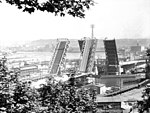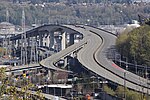Lockheed Shipbuilding and Construction Company
1959 establishments in Washington (state)1988 disestablishments in WalesAmerican companies disestablished in 1988American companies established in 1959Defunct companies based in Seattle ... and 4 more
Defunct manufacturing companies based in Washington (state)Defunct shipbuilding companies of the United StatesLockheed CorporationShipbuilding in Washington (state)

Lockheed Shipbuilding and Construction Company (a.k.a. Lockheed Shipbuilding), was a shipyard in Seattle, Washington with Yard 1 on Harbor Island and Yard 2 at what is now Jack Block Park at Seattle Terminal 5, both at the mouth of the West Waterway of Duwamish River. Yard 1 was founded in 1898 as the Puget Sound Bridge and Dredging Company, the company that built Harbor Island, and it was purchased by Lockheed in 1959. Yard 2 began operation in 1943 to build ships for the US Navy. The shipyard was permanently closed in 1988; Yard 2 was sold in 1989, and Yard 1 was sold in 1997, both to Port of Seattle.
Excerpt from the Wikipedia article Lockheed Shipbuilding and Construction Company (License: CC BY-SA 3.0, Authors, Images).Lockheed Shipbuilding and Construction Company
16th Avenue Southwest, Seattle
Geographical coordinates (GPS) Address Nearby Places Show on map
Geographical coordinates (GPS)
| Latitude | Longitude |
|---|---|
| N 47.5766 ° | E -122.3581 ° |
Address
16th Avenue Southwest 3205
98134 Seattle
Washington, United States
Open on Google Maps








